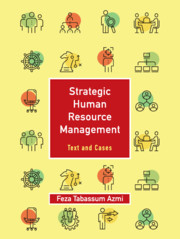Preface
Published online by Cambridge University Press: 26 April 2019
Summary
With the ever-escalating challenges of the business environment, the corporate world is fast realizing the importance of human resource (HR) as an inimitable strength for attaining sustainable advantage. This has given place to the idea that human resource management (HRM) needs to be aligned to the strategic management (SM) process of the organization. The integration of the above two disciplines is termed as strategic human resource management (SHRM).
Academic debates around the 1980s and early 1990s suggested the need to integrate SM and HRM closely. These debates highlighted the growing strategic nature of the HR function. The concept of SHRM became popular in the 1980s with the development of two models that talked about integrating strategy and HRM, namely the Michigan Model and the Harvard Model. Academic writings in SHRM started to emerge after this, but it was only by the end of the 20th century that the practice gained popularity and momentum among practitioners.
In recent times, SHRM has become a well-accepted concept and practice. Today, HR is seen as potential contributors to the realization of the organization's vision. It is interesting to note that HR departments are now considered to be investment centres rather than cost centres. HR executives are today considered as important strategic partners. The increasingly important role that HR managers are playing today is exemplum of the fact that SHRM has arrived. There now exists empirical evidence that documents the contribution of the strategic HR approach to organizational performance.
Despite the increasing importance of SHRM, there is still a paucity of texts on SHRM in the context of emerging economies, more specifically in the Indian context. The volatile and dynamic business environment of emerging markets warrants an increasing focus on valuing HR and linking HR issues with strategic imperatives. Keeping in mind the fact that India is one of the fastest growing emerging markets today, this book is expected to provide insights into the fast-evolving SHRM terrain.
Almost all B-schools and universities offering management courses teach papers related to the area of HRM. However, the dearth of books on SHRM makes the task of teachers and students quite challenging in terms of obtaining relevant and contextual matter on the subject.
- Type
- Chapter
- Information
- Strategic Human Resource Management , pp. xv - xviiiPublisher: Cambridge University PressPrint publication year: 2019

